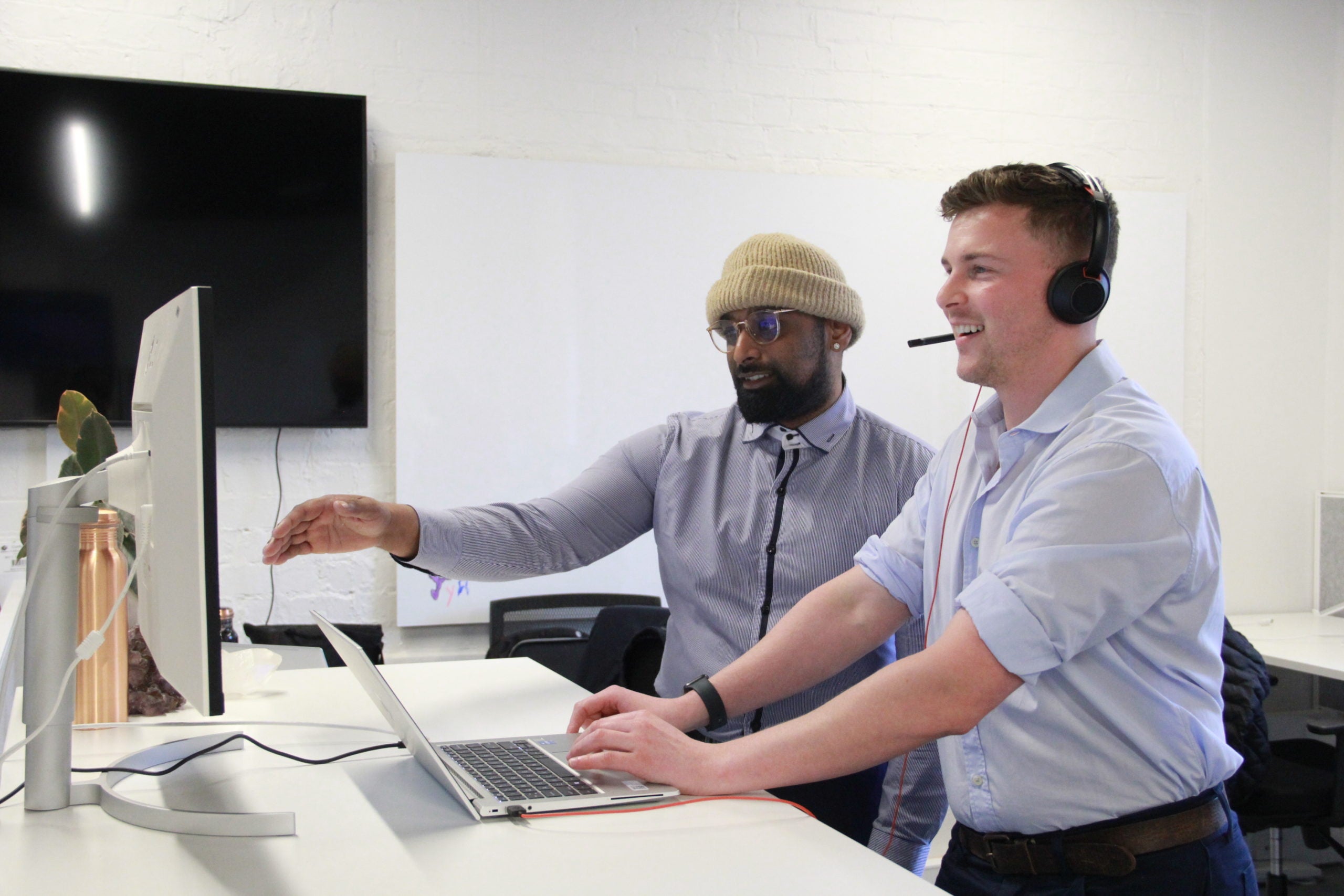Category: Blog
Blog
Designing the Future of Learning – An Inside Look into New Zealand’s Education Landscape with Developers Institute

“Technology doesn’t just replace jobs, it also creates them.” – New Zealand Productivity Commission
A global shift in business priorities, technology adoption, workforce capabilities and skills shortages have fundamentally changed how we learn and work.
The pandemic’s impacts have been anything but easy to predict. While experts may have predicted the remote working trend, profound skills shortages and low unemployment rates have shocked many. When the Treasury released their 2020/21 forecast, many labelled it as unrealistically optimistic, despite unemployment rates hitting record lows and skills shortages more prevalent than ever.
We’ve heard time and time again that the pandemic has accelerated the future of work – and it has – but in many unexpected ways. We spoke to Isabelle Bierwirth of Developers Institute, a leading education provider specialising in web and software development training, about the changing tech industry and how training will be vital in addressing this emerging crisis.
A round-up of insights into New Zealand’s tech sector
The technology sector is New Zealand’s second-largest exporter, with the top 200 exports generating over $13.9 billion in revenue in 2021. In 2020 alone, New Zealand’s tech sector had 23,292 companies and employed 111,760 workers. These figures are only expected to grow.
Additional research shows that each new job in the tech sector creates 4.8 new jobs in the service industry, such as marketing, sales, and customer service.
This growth is critical as it enables NZ’s digital economy to:
While the tech sector may be expected to spike rapidly over the next few years, experts are concerned there may not be enough talent to do the work available.
NZTech Chair Mitchell Pham said, “New Zealand’s tech talent shortage has been pushed to critical levels” due to NZ’s heavy reliance on immigration and border closures.
Why are there tech skills and worker shortages?
A recent survey found over 2,100 open roles at the 271 firms surveyed. 41% of firms were unable to take on new work requests and 29% were unable to complete the work currently underway, therefore unable to meet client expectations.
“Right now, there’s not enough talent to do the work that is currently available. What we’ve got is demand outstripping supply,” says NZTech CEO Graeme Muller.
Echoing this sentiment is Isabelle Bierwirth, Head of Marketing at Developers Institute.
“Talking to our network of tech workers, we’ve found that there is not enough talent to meet the current demand – and it won’t get any better unless we prioritise tech training,” says Bierwirth.
While the tech sector, both in New Zealand and globally, is experiencing exponential growth, the tech worker shortage is creating an “aggressive poaching cycle”. This cycle only represents the small number of talented workers moving from company to company, rather than the sector’s growth as a whole.
But where is the worker shortage originating from? While border closures, lack of immigration and growing worker expectations may be to blame, Muller says the shortage has “to do with a much more complex fault within our education system”.
When examining the full pipeline – primary schools, secondary schools, universities and the sector as its whole – there seems to be a lack of positive perception about tech roles. This has translated to a declining number of students interested in them and a declining number doing degrees and coming out the other side.
Muller says an Industry Transformation Plan will aim to address the current problems in the pipeline. The plan will support the migration of skilled workers, training more university students and upskilling current tech staff.
A case study – How one education provider is delivering vital tech training in New Zealand
Meet Developers Institute
Developers Institute is a leading New Zealand training, specialising in web and software development training.
Their mission is to provide accessible, affordable and transformative vocational education, which leads to meaningful employment. They focus squarely on helping people to realise and reach their full potential through education, training and jobs, encouraging growth in the technology sector in New Zealand.
Developers Institute was founded in response to a lack of software development education offerings, despite growing demand locally, nationally and globally for trained developers.
How is the Developers Institute doing its part to combat the tech skills shortages?
Developers Institute aims to create the conditions for practical learning experiences for students – school leavers, upskillers and career changers – to develop the skills required to meet new challenges of the tech industry.
They model the software development culture in the learning space. Their programmes use the institute’s close relationships with industry partners to facilitate industry mentorship, with instructors working alongside industry mentors to support student success.
Bierwirth says, “All our instructors are industry professionals, ensuring our curriculum remains current and relevant for the working world. We are committed to understanding and implementing a strategy that provides professional training and education, meeting the requirements of a good developer in the marketplace.”
“Our access to industry professionals enables us to find out what our peers need in the industry, and how they are seeing the industry evolve. We then use these insights to shape, build and scale our training programmes.”
Where is the future of education heading? And how is the Developers Institute enabling it?
In Australia, disruption and uncertainty have spurred lingering questions about the state of education – what it will look like and how it will impact both learners and educators.
However, Australia isn’t the only country wondering about this. The entire Asia Pacific region is one of the fastest developing regions globally, and now comprises 32% of the global elearning market’s growth.
Like many others, New Zealand’s education system is facing some challenges.
While there are multiple opinions on remote learning, Bierwirth says, “it’s clear students want continuous access to teachers”.
“Students want the flexibility of learning anywhere, they want to remain on the pulse of industry trends. And they do that through our industry mentors and trainers.”
Developers Institute is the perfect online learning case study.
Their first-ever cohort commenced as New Zealand went into their first COVID-19 lockdown. From the get-go, the training provider had to pivot, and as of October 2021, they have successfully transitioned into a remote training institute for students and staff.
Micro-credentials vs diplomas – How and what do students want to study in the tech industry?
Bierwirth believes that what students study “depends entirely on the desired outcome of the programme”.
“For people wanting to upskill their existing tech knowledge, micro-credentials would be a good option.”
“For those new to the tech industry, for example, career changers, an industry-led programme like the one Developer Institute offers provides them with the best outcome to find employment afterwards.”
“The feedback we get from our partners is that students who completed boot camps lack work readiness, particularly when joining a fully remote workplace, and typically require additional training once employed.”
“Some of our graduates are employed as intermediate developers after completing our programme. Our training requires them to immerse themselves into a remote work setting which is very similar to our learning environment, setting them up for success later down the track.”
Changing economic priorities, labour market conditions and skills shortages have left the tech industry shortchanged. But speaking to Bierwirth, it’s clear that education providers will be integral to addressing and solving this crisis.
Thank you to the Developers Institute for taking the time to discuss the importance of industry-aligned skills development and training in our post-COVID-19 ecosystem.
Want to know more? Read about tech and STEM industries in ANZ.
Blog
How Providers Can Create an Immersive University Experience for Distance Learners

With 50% of students now opting for online study over blended and in-person only learning, universities have an excellent opportunity to raise their game and ensure that distance learners are getting the best education experience possible.
But what are some of the best ways to do this, and how can universities optimise their approach?
Create a stronger connection between education and industry
One of the best ways to make a student’s learning experience more immersive and rewarding is to place employer and industry engagement at the heart of their tuition. Distance learning can sometimes mean that students miss a connection with a new town or city with different industries, but this can be remedied through a few different strategies.
Speed dating” scenarios with employers
A university in Canberra, Australia, set up a programme where students have short meetings with a wide range of employers in one sitting. Similar to the format of speed dating, the idea was to give students an insight into many different employers and industries, allowing them to form opinions on which appealed to them the most.
The main benefit of this exercise was to help students tackle the overwhelming task of understanding different industries and the wider job market. Sometimes, students can be so busy with their studies that it can be hard to fit in time to research employers and future job opportunities.
Networking sessions and digital industry experiences
Setting up virtual networking events can be an excellent way to improve engagement amongst students and offer them an immersive networking opportunity.
Recent data shows that in London and the north-west of England, around 66% of students find work close to where they studied and stayed in their university town or city. Conversely, the same study found that just 44% of students in the south-west of England ended up working near their university, and 42% of students in the East Midlands stayed in the area.
Universities providing distance learning have a significant advantage, as they can connect students with employers in a digital setting through online networking events. This allows students to interact with potential employers from all over the country and even worldwide. This opens them up to a huge range of opportunities and encourages them to look further afield than their local area.
Working with industry leaders in a virtual setting can be vital for high levels of post-education employment. We put work-based learning and digitally delivered industry experiences as one of our top four solutions for providers looking to increase the scope of their digital education delivery.
Helping students learn from each other
Focusing on delivering education that focuses on student interactions with each and alumni can help you to give your students a learning experience that keeps the social element of in-person learning.
Peer-to-peer learning
Encouraging students to learn from each other can be an excellent way to enhance a distance learning experience — the key is to encourage and facilitate as much discussion as possible.
For in-person learners, interaction can be a bit more straightforward and self-led, as you can have asides and personal conversations without involving the whole class, but online lecturers can easily organise virtual breakout sessions and group activities within seminars as well.
It can be difficult to facilitate fluid virtual meetings with large groups, so mixing it with a more agile format of discussion can give students a learning experience more akin to in-person learning.
Alumni and older student-led mentoring
Keeping your alumni engaged and involved with new and potential students can help create a seamless pipeline of eager learners. This can be incredibly useful for lead generation, and it can also allow you to make students’ learning experience more immersive and commutative.
Using mentoring programmes, either with older students who can pass on knowledge to first or second years or through involving alumni with a particular module, can be an effective way to feel connected to course content directly.
King College London matches students with alumni mentors for a six-month period over the academic year, where pairs are encouraged to meet once a month.
For providers who administer distance learning, you may find it much easier to get talented alumni to commit to becoming a mentor, as the student sessions can take place digitally. This means that there’s no issue of location, and the impact on the spare time of your alumni is minimised.
Distance learning can rival and even supersede the immersion of in-person learning.
Through using dedicated and well-thought-out methods, distance learners can get the best learning experience possible.
Blog
Nailing Your Content Strategy: 5 Tactics to Attract Students via Content

Content marketing is one of the best ways to boost your brand and engage your customers, regardless of which industry you’re in.
When it comes to the education sector, content should be a key aspect of every provider’s marketing strategy. It can help you reach more students, support their decision-making process and empower them to pursue their education and career goals.
The versatility of content makes it the cornerstone of every marketer’s toolkit.
Short-term, content provides financial value in the form of leads and revenue. Long-term, content improves the lifetime value of your customer – from attracting student traffic to nurturing prospective students through their learning journey.
If you’re ready to invest in your content marketing, here are our top five tips.
Define your content pillars
As you’re planning future content, aim for a balance across the funnel. It’s important to diversify your content strategy so you can reach your audience at every stage of the student journey.
If you’re attracting thousands of readers every month as a result of great SEO, but none of your content converts, you may be lacking bottom-funnel content. Alternatively, if you have compelling success stories and testimonials but no eyeballs landing on them, your content strategy may benefit from more search content.
At Candlefox, we’ve adopted a three-pronged approach to our content strategy:
1. Search content
Top-funnel content that is produced specifically for search algorithms and involves targeting relevant keywords. This type of content is created and optimised for user search intent.
2. Sales enablement
Bottom-funnel content type showcases your products or services in action. In the education industry, these can be testimonials, success stories and interviews that highlight the benefits and outcomes of your course.
3. Thought leadership
Content that leverages your authority as an education provider and leader in your field. For example, if you specialise in providing aged care training, create content that demonstrates your unique knowledge and credibility.
Experiment with content mediums
There are a variety of content mediums to create, produce and distribute – anything from ebooks and blog posts, to infographics and podcasts are fair game.
The best content marketing strategies incorporate a solid mix of short and long-form, written and visual content.
If you’re feeling overwhelmed by choice, here are six popular content types for you to choose from:
Blog posts
55% of marketers say blogging is their top inbound priority. Medium to long written content, such as blogs and whitepapers, enable you to increase your site traffic, improve brand awareness, boost conversions and increase your revenue.
Quizzes
Quizzes or forms – like our Course Navigator – are incredibly effective lead generation tools. The interactive nature of these forms means learners can engage with your brand and content no matter which stage of the funnel they’re at. They’re also handy for capturing content information and data for future nurture strategies.
Infographics
Infographics organise and communicate data in a more compelling, snackable format. Because of their ability to break down large amounts of data, they are a great medium for readers who may lack the time to read a 1000 word article. They are also a great option for those who enjoy a healthy mix of written and visual content.
Videos
People are consuming more video content than ever – the average person is predicted to spend 100 minutes per day watching videos online. Not only does this make it a great opportunity for more readers to consume your branded content, but video has proven to boost SEO.
Landing pages with videos are 53% more likely to rank on the first page of search results. So, although videos require bigger time and resource investments, its benefits and ROI significantly outweigh the cost.
Podcasts
Although the newest medium on this list, podcasts are giving other content forms a run for their money. Like video content, podcast consumption is on the rise. In fact, postcasting will be a $94 billion industry by 2028. New technologies and the growing involvement of celebrity talent has made this a medium to watch.
Get social!
Once you’ve established a regular publishing schedule, you may want to think about how you can expand your content reach via various distribution methods. Social media is the most popular choice for content distribution among marketers.
Worldwide, people spend an average of 2 hours and 27 minutes per day on social media. Therefore, using social media means being where your customers are, and reaching thousands of additional prospective learners.
When it comes to distribution, you may want to:
Regardless of publishing or distributing, you’ll want to adjust your content to better suit the nature of the social platform you’re on.
For example, on Facebook, we noticed that users interact with content at a much higher rate when there is no hard-sell. Users tend to prefer content that fosters engagement, two-way communication and healthy discussions. On more visual-based platforms, such as Instagram and TikTok, you may find short-form video content more impactful.
Therefore, take the time to conduct market research and identify which platforms your learners are on, and which content might suit them the best.
Harness the power of social proof
Success stories, interviews and testimonials should be a core pillar of every content strategy.
Sharing successes from past students can really concrete a prospective student’s willingness to study. Not only do they outline to the learner what their post-study outcome might look like, but they can also help build credibility for your brand.
Besides the obvious reasons – such as the direct impact on revenue – many marketers prefer producing success stories over other types of content. This is because they are actually one of the more versatile types of content. Testimonials and case studies can take on various forms – blog posts, ebooks, infographics, videos and podcasts.
However, it’s important to keep in mind that the outcome, rather than the content, is what resonates the most with students.
Remarketing with content
Content has much more value than supporting short-term lead generation. When used correctly, it is an extremely valuable retargeting tool.
Take a prospective learner who is visiting your website. If they navigate to any commercial or course pages, you now have valuable information on what subject areas they’re interested in and which courses they may be looking to enquire about.
Having this vital information allows you to nurture this learner to conversion by serving them content you know they’ll be interested in.
If a prospective learner has navigated through several course pages but has not enquired, they are demonstrating low-intent signals. Instead of funnelling this learner back to the course page where they are still unlikely to convert, direct them to informative content which can better assist their decision making process.
Better yet, encourage them to middle and bottom-funnel content with job outcome data and student testimonials which are more likely to push them to enquire.
This tactic is more of a ‘softer sell’, because it is less intrusive than typical advertisements and provides value to the learner.
While it can be tempting to churn out new content every week, stop and think about what value your existing content can bring – whether that’s through repurposing, distribution or remarketing.
And if you’re on the other side, where content is not a big focus in your marketing strategy, it might be time to reconsider. Add rich value to your digital marketing strategy by experimenting with a range of content themes and mediums.
Blog
The Highest In-demand Occupations and Industries for VET in 2022

Australia is in the midst of a jobs boom.
Contrary to initial assumptions, our labour market has rebounded from the pandemic rather well. With unemployment sitting at just 4.2%, more jobs are available than ever.
Historically, we have relied on the migration of workers to solve our labour market issues. However, with border closures and restrictions, we must shift our focus towards skilling workers and creating a better-matched supply and employment demand on Australian shores.
To do this, we must forecast which occupations are going to be in the highest demand and build resilience and adaptability into our education and skills system.
A forecast of the Australian labour force
Following the easing of Delta-outbreak restrictions, job openings between September and November increased 18.5% (396,100) from the previous three months. This figure is almost three-quarters higher than pre-COVID levels during February 2020. 64,800 jobs were also estimated to have been created between November and December.
“These figures continue to show the high demand for workers from businesses emerging from lockdowns, together with ongoing labour shortages, particularly in lower-paying industries,” said Bureau’s Head of Labour Statistics, Bjorn Jarvis.
All sectors of the economy reported higher vacancies, led by the private sector with job openings at 361,700. Labour analysis by NAB indicated approximately 40% of all Australian businesses were feeling the talent ‘squeeze’, with larger businesses hit hardest.
The huge demand for workers, and a relative lack of supply from international borders, are prompting many employees to consider a career move. This mindset shift highlights critical questions about how Australia’s education system can keep pace with these demands and which occupations and industries we should focus our attention to.
1. Medical practitioners and nurses
The care industry has always been one of the most important industries in Australia – and one that has grown and will continue to grow as we navigate through the ongoing effects of COVID-19.
The pandemic has created a sustained need for all types of care professionals – long-term care facilities, schools, hospitals and urgent medical centres are all looking for nurses and medical staff. Positions in outpatient care centres and home healthcare agencies are growing quickly.
In Queensland, nursing and health care courses are the most sought-after among school leavers in 2021. Queensland’s universities and TAFE institutes issued some of their highest offers in their Diploma of Nursing and Bachelor of Nursing.
This news is not surprising, given that registered nursing jobs are expected to grow by 46,500 (15.6%) over the next four years.
2. Aged and disabled carers
The National Skills Commission has predicted that aged and disabled care employment will skyrocket by 2025. As Australia’s population ages, the demand for aged care will increase with it.
The ‘State of Australia’s Skills 2021’ report estimates that aged and disabled carer jobs will grow by 54,700 (24.7%) over the next four years.
Serious staffing shortages in the aged care industry have also prompted TAFEs and education providers, such as Griffith TAFE and Uniting NSW & ACT, to offer aged care training.
3. Data scientists
Today’s modern world runs on data.
Whether it’s financial insights, understanding customer behaviour or research, people who can manage and reason over large amounts of data are in high demand.
According to the National Skills Commission, “data scientists find and interpret rich data sources, manage large amounts of data, merge data sources, ensure consistency of data-sets, and create visualisations to aid in understanding data. They build mathematical models, present and communicate data insights and findings, and recommend ways to apply data.”
Because of this, we can expect almost every company to employ at least one data scientist.
4. Software engineers
Technology roles have long featured on the emerging jobs list and will continue to dominate a large percentage of our jobs market.
But it’s not just the tech industry that requires tech talent anymore – almost every industry and business are shifting to digital products, which will inevitably require tech workers.
The rapid emergence of roles like software engineers and full-stack developers makes sense.
Most business and casual interactions moved online during the height of the pandemic, and they’re expected to stay there. The technology that enables these interactions requires highly-skilled, specialised workers to create and maintain it.
The versatility of software engineers means they are in hot demand across various industries and companies looking to add tech capacity as efficiently as possible. Jobs in software and applications programming mirrors this sentiment, and are expected to increase by 30% between now and 2025.
Emerging education providers – the likes of Developers Institute – are committed to providing specialised, industry-driven training to meet this demand for developer talent.
Digital strategists, marketers and experience designers, among other emerging occupations
The World Economic Forum predicts 97 million global roles will emerge over the next five years. These roles will be a hybrid of new occupations and existing ones, requiring digital and human components.
Other emerging occupations include:
Our previous blog unpacked the top 10 in-demand jobs of 2020 and 2021. While some of these have decreased slightly in demand, they are still as important as ever.
We need to limit our dependence on the attraction and migration of skilled workers from outside Australia’s borders.
To create a better-matched supply and demand of workers, we need to bolster our education and training system and continue to cultivate a culture of lifelong learning and upskilling.
Blog
3 Strategies to Help Providers Establish a Lifelong Learning Partnership with Employers

Establishing long-term partnerships with employers is an excellent way to guarantee a steady stream of reliable and eager students.
These partnerships enable you to predict how many new students you’re likely to take on and when, streamline your enrolment process, identify which emerging and in-demand skills your client will need ahead of time, and build new courses to solve these skills gaps.
But what is the best way to build these partnerships? How do you best communicate the benefits of lifelong learning to employers?
In this article, we’ll go through three key strategies to build a resilient and robust relationship with clients based on the principles of lifelong learning.
What is lifelong learning?
Lifelong learning is an approach adopted within the workplace that centres around the idea that professional development should be more than one-off courses – proper training programmes should build the skills and knowledge of workers throughout their entire career.
Education providers should collaborate with employers to provide consistent and relevant training suited to each company’s needs, that can be then ascribed to individual employees.
Rather than filling in skills gaps when they occur, a provider will be able to help a company prevent emerging skills gaps in the first instance.
Additionally, employers will be able to build a culture of lifelong professional development, helping their workers realise their true potential.
What are the benefits of lifelong learning for companies?
The best way to entice clients into taking on lifelong learning practices within their workplace is to demonstrate its benefits.
Companies that build and invest in long-term plans to upskill their workforce will see improvements in several areas, including retention, acquisition and company morale. This, in turn, can lead to higher productivity and increased profits.
Here are three key benefits:
An increase in retention
Keeping highly productive and valuable employees should be the aim of any company. But it’s all too easy to let good talent slip through the cracks and move onto new places.
Some employers will have trouble nailing down the key reasons why they struggle to keep employees for longer periods of time. This can be a serious issue if they can’t find a way to get on top of it.
According to the latest research, the average cost of replacing an employee earning £27,000 a year can be as much as £11,000.
Research from LinkedIn shows that establishing a dedicated and long-term training programme can help prevent significant turnover. The research has found that 94% of employees said they would stay at a company longer if they invested in their career.
As COVID-19 has demonstrated, there is still room for improvement training across every workforce. Education providers can be more proactive in approaching, and assist companies to see the big picture and understand the financial incentives of establishing a culture of lifelong learning.
Attracting new talent
Lifelong learning is an incredibly useful tool for recruiting the best talent to your company.
A survey from Forbes found that 86% of workers said that they would change jobs if it meant there would be more opportunities for professional development.
Therefore, a company that invests in ongoing professional development will have a competitive advantage in the labour market. Those who offer and promote lifelong learning may find themselves sourcing – and even poaching – valuable talent from their competitors.
The impact of lifelong learning on attracting and building a wealth of talent is undeniable. Providers should leverage these benefits to form meaningful, two-way relationships with employers.
Protection against staff shortages
A third of UK businesses experienced a shortage of workers last year, with the most common reasons being a lack of new and qualified applicants.
Skills and worker shortages can damage morale and stretch resources within companies. The same survey revealed that over 60% of businesses reported staff working longer hours to make up the difference.
Providers should look to demonstrate how companies can train from within in order to mitigate the risks of staff shortages.
Together, providers and employers can establish a clear professional development path for each employee. Employers who plan to upskill employees will be better positioned to adapt and solve unexpected skills shortages.
How to sell your lifelong learning programmes to companies
After explaining the benefits of lifelong learning to companies, it’s important to understand how you can grow and scale the courses you provide to grow alongside them.
Understand their goals and needs for the next month, year or decade
Companies can scale at high-speed rates, and being able to cope with new employees, new departments, and new educational needs will be vital if you want to establish a long-term education journey with them.
How can you help them to scale?
The key strategy is to understand where the company sees itself going and demonstrate how you can keep pace with their emerging demands. Before approaching employers, know exactly which courses you will be able to deliver and which courses you plan on developing soon. This will streamline and strengthen your initial conversations with them.
Where are they looking to build talent?
Speak to representatives of the company about what their overarching vision is and align your mutual goals to this. A brick-and-mortar store that only needs training in specific areas might also benefit from training with UX design and web development down the line if they choose to move into e-commerce.
How to provide the best plan possible
Once you feel that you’ve explained the benefits of lifelong learning to a potential client and have established the critical points of growth and expansion they will be focusing on, it’s time to provide them with an in-depth, tailored plan.
Build out from case studies from previous clients
If you’ve worked with similar companies before, or have seen success in establishing a lifelong learning programme with other clients, use this as a base to work from.
As you learn more about the business’s unique needs, you can begin to tweak your programmes to better suit your new client.
Employers and companies alike want to know your success with implementing lifelong learning programmes. Demonstrate your previous wins through testimonials, case studies and media kits.
Learn and use industry knowledge
Find key examples of companies who have the best reputation in the industry and become an expert on the best courses, skill areas and practices for employees in the sector you’re looking at.
Remember, it’s about more than just keeping up with the competition. Your lifelong learning programme needs to be able to react to changes in the industry, be up to date with the latest technologies and innovations and will allow your clients to always be one step ahead of the competition. You should know the sector inside and out before providing a lifelong learning plan to companies.
Lifelong learning can be a great opportunity for both providers, employers and the broader workforce.
Establishing this style of partnership with clients can help you generate a reliable stream of high-intent students, whilst providing them with a wealth of benefits such as employee retention, talent acquisition and employee satisfaction.
If you’re curious about how you can take your workforce development and corporate training to the next level, get in touch with our sales team to discuss how Candlefox can help you.
Blog
Email Marketing for the Student Journey

When it comes to maximising your enrolments, email marketing and automation is essential to nurturing and converting prospective students.
During the first phases of the student journey – discovery and consideration – learners actively seek information on courses. They’ll do this by exploring your onsite information, student resources and peer feedback.
A follow-up strategy should nurture learners ready to escalate their decision-making process. Once students have shortlisted their course of choice, they’ll most likely attempt to source further information via email, phone or direct contact with your course advisors.
Our previous blog provided best practice post-enquiry techniques to maximise enrolments via phone enquiries and lead nurturing. However, these strategies need to work in tandem with email marketing.
Email marketing sets you apart from your competitors, provides additional information, and enables your learners to make more informed decisions about their studies.
Here are five elements that make email marketing successful.
Timing is everything
Send your first email instantly.
When a user enquires about a course via a form on your website, the last thing you want to do is keep them waiting. Reduce their waiting time by setting up a triggered welcome email.
A triggered email sent immediately after enquiry will ensure you keep learners engaged and your brand front of mind. This is because triggered emails have higher open rates than standard emails. Our data shows that our triggered welcome emails are opened three times more than standard emails.
When you make a purchase online, you expect to receive an email instantly acknowledging your order.
The same principle applies to course enquiry and student enrolments. Learners are expecting to receive an email acknowledging their interest, receipt of their enquiry and further information on next steps.
While timing criticality is important, the content of your emails and subsequent interactions is equally important. Together, all three elements help you to build a more streamlined user journey, converting more prospective students.
Set expectations
Set clear expectations in each email.
Following their enquiry, learners will want to know about next steps. It’s crucial to address this in the welcome email and set expectations for future interactions.
If the next step is for the learner to receive a call from a course advisor, communicate this clearly. If possible, establish some guidelines – let them know when they’ll be contacted and who will be contacting them. Better yet, if your technology allows, give the learner the option to schedule when they receive the call.
This helps to set yourself and your course advisors up for success. You’re fostering a positive sentiment with learners, increasing your contact rates and improving the quality of the conversations with prospective students.
Below is an example of a welcome email that clearly sets out learner expectations.

Keep it personal
Talk to the individual, not anyone and everyone.
A strong email marketing strategy is sending the right message at the right time. If you’re not personalising follow-up emails, you’re not providing value. And if you’re not providing value, learners will simply look elsewhere – more often than not, they’ll turn to your competitors.
According to Campaign Monitor, personalisation increases customer engagement. On average, personalisation increases sales by 20%.
Some simple ways to increase the level of personalisation in your emails include:
Don’t overdo it
Frequency can make or break your email marketing campaigns.
While it’s important to follow up with your prospective students regularly, too much can be a bad thing. Too many touchpoints can make your email marketing campaign feel like spam.
As a general rule, avoid sending them out too often. However, every business is different. So it’s important to test and find a sending frequency that achieves the best results for you.
To determine if your frequency is effective, analyse your emails. Look for changes in your open and click-through rates, conversions and unsubscribes. If you notice increases in the first three metrics and a decrease in the last metric, you’re on the right path.
Test, test and test some more
An email sent without a test is a wasted opportunity to learn.
Every marketer knows how important it is to get into a habit of testing everything.
No test is too small or unworthy – even a seemingly minor change can have a major impact on conversion rate. A slight variation in the copy or a minor adjustment to the layout can significantly impact your results.
It’s imperative to know what metrics to look at when evaluating the results of an A/B or split test.
While it’s standard practice to evaluate A/B results based on either open or click-through rates, they sometimes don’t paint the full picture. Combine these indicators with other metrics such as your conversion rate to effectively analyse performance.
Explore the following scenario: You’re testing two subject lines.
Subject Line A achieves an open rate of 20% and Subject Line B achieves an open rate of 18%. On the surface, subject line A is the clear winner.
But when you deep-dive into the conversion rates of each, you may find that Subject Line B was in fact the better performer, generating significantly more enquiries, transactions or sales.
This could indicate that Subject Line A was misleading and didn’t resonate with the needs of the learner. On the other hand, Subject Line B, while not having the strongest subject line, best met the learner’s requirements.
While this is an example for illustrative purposes only, it highlights the importance of looking beyond opens and clicks when evaluating any test.
There are so many elements to consider when designing your email marketing strategy. At a fundamental level, your strategy should be built around anticipating the needs of your end user and exceeding their expectations.
We suggest starting simple and building a more complex strategy as you identify your learner’s needs.
When done well, email marketing can drive significant revenue and build long-term relationships with your learners.
If you’d like to learn more about post-enquiry nurturing, get in contact with us today!
Blog
How Developers Institute Built a Winning Digital Marketing Strategy with the Candlefox Marketplace

Building a winning digital marketing strategy is a mission for well-established education and training providers, let alone those in their early stages.
Boosting enrolment volumes and improving ROMI was a priority for Isabelle Bierwirth, Head of Marketing at Developers Institute. Still in their youth phase, Bierwirth understood the importance of marketing and lead generation, and knew they needed to diversify their strategy and nail their marketing mix.
Since 2019, Developers Institute has leveraged Candlefox’s learner-centric Education Marketplaces to amplify their course marketing and student recruitment performance.
So, how have these market-leading solutions contributed to higher student enrolments and fuller quarterly student intakes and enrolments?
Meet Developers Institute
Developers Institute is a leading vocational education provider in New Zealand, specialising in web and software development training.
At Developers Institute, their curriculum is cutting-edge, industry-driven, and agile. Their instructors are experienced professionals at the forefront of programming and coding.
“We’ve noticed that there is a big gap in the software development industry. We’re seeing employers struggle to support junior developers as they transition from study to experience. While there are senior developers that can help to mentor these graduates, they often lack the time or capacity to do so,” says Bierwirth.
“Developers Institute helps fill this crucial gap. Our instructors are mentors to some of Australasia’s future leaders in software development.”
Challenge
Developers Institute was a relatively new training provider when approached by Candlefox’s Partnerships team.
Established in 2017 and very much still in its early stages, Bierwirth says they were juggling multiple pieces of the brand, marketing, and sales puzzle at the time.
During a discovery call, she identified three main priorities for Developers Institute:
Finding the right marketing mix.
While they were going to utilise traditional marketing channels such as Facebook, Instagram, Google and other advertising platforms, they were eager to explore a marketing channel that could provide them with stable, predictable costs and results across the entire year.
Being at the front of mind of prospective students.
Being a newer provider, they wanted to increase their brand’s exposure to prospective students and increase their market penetration.
Performance consistency and tracking.
Performance and ROMI (Return on Marketing Investment) underpins every marketing strategy. Bierwirth wanted to ensure that the marketing partner they chose could provide data in real time.
These three priorities in combination ensured stronger marketing performance and fuller quarterly student intakes year-round.
“We were looking for a channel that could form a core part of our marketing strategy,” says Bierwirth.
“When Candlefox approached us over LinkedIn, it made sense to partner with them. Their approach to brand and course marketing – primarily leveraging structured, sound and SEO-heavy initiatives – seemed like a good fit for us.”
How Candlefox helped
Candlefox now plays an important role in their marketing and lead generation ecosystem.
Many providers in today’s digital age are concurrently running paid social (Facebook, Instagram, and LinkedIn), paid search, and other advertising campaigns.
Education Marketplaces are newer – and often untapped – marketing channels for education and training providers across Australasia. We tap into our owned marketing channels to provide our partners with consistent leads every month of the year.
Nailing the marketing strategy is one feat, converting students in the enrollment funnel is another.
In addition to our lead generation services, we provided Developers Institute with best-practice techniques and tips to help them nurture and convert their student leads.
Speaking to their onboarding experience, Bierwirth said: “We started the relationship with Candlefox with a 3-month onboarding and ‘trial’ period. Flexibility was crucial to us – and Candlefox understood this. They listened, adapted, and worked with our needs.”
Results
Since partnering with Candlefox, Developers Institute have seen improvements across multiple fronts, including:
Developers Institute has received a consistent volume of pre-qualified, high-intent student leads, contributing to their fuller student intakes each quarter.
Bierwirth says partnering with Candlefox was a great decision.
“We receive more certainty around student leads. We understand that we always have a baseline of leads to count on.”
“In addition to this, they provide us with great exposure to an audience of high-intent prospective learners. They have cultivated a nice synergy of learners actively researching and enrolling in courses.”
“In some way, Candlefox became our marketing manager, and helped us grow our business.”
Discover how Candlefox can support your brand and course marketing activities. Get in touch with the team today.
Blog
What is Backlinking? (And Why Education Providers Should Care)

For any business looking to market themselves and reach customers, backlinking can be a massively helpful tool.
Backlinks are links on other websites that link back to your own site. This is different from linking pages to one another within your own site, as these inbound links are coming from an entirely different source.
But how can education providers take full advantage? How do backlinks help generate traffic, increase conversions and improve on-site SEO?
We’ll go through some of the critical methods that you can use to help take your SEO and web presence to the next level.
Why should education providers care about backlinks?
Boosting your backlink profile improves your onsite SEO and can help make a splash on Google’s front page. Although you may not see results overnight, establishing a long-term strategy that is based around quality content and links to sites that use quality SEO practises is the best way forward.
Backlinks help with your Google Ranking
Google is one of the most popular search engines globally, so appearing high up on a Search Engine Results Page (SERP) for valuable search terms is an excellent way for customers to discover you.
Google Ranking describes how high you show up in search results and varies from search term to search term. So, if Google ranks your content highly, then you’ll be amongst the first few results that appear.
Ranking highly on Google’s search results can have a huge impact. A study from Backlinko found that moving up to the number one position on Google for a search term can boost click through rate by as much as 31%.
Backlinks help Google decide whether your content is actually relevant to a user’s search query. One way is by using factors to determine how trustworthy you are as a source.
If other websites link to your content, Google trusts that you are a reliable source of information. Many sites could reference you as a recommended education provider if they link to your home page. If it’s a specific piece of content, many sites might have quoted you as a reliable thought leader or valuable source of information that backs a point they’re validating.
Google is constantly working to decide how reliable your site and content are for a particular search term as a place for quality information. Backlinks are one of the most powerful tools you can use to make the case that you are a good source.
Builds your reputation
Appearing on other websites shows your potential students and other institutions that there is significant interest around you and the services you provide.
Much in the same way an author or academic might gain additional credibility by being featured in lots of newspapers, this same principle is true for backlinks from other sites. If you already have an outreach strategy to promote your expertise, layering a backlinking strategy over it can be easily done. It can quickly boost your Google rankings and online presence.
Backlinks can increase Google’s level of trust in you, and this goes for people as well. In the same way providers use LinkedIn or other social media to promote themselves, the same approach can be taken with backlinking. Getting your name out there through backlinks generates greater interest around you while also positively impacting your Google ranking and onsite SEO. The process of manually acquiring links is known as “outreach.”
It can attract more traffic and increase conversions
A study from Ahrefs found that across 920 million web pages, the higher level of traffic correlated with the number of referring domains. Simply put, those websites which are being linked to by a greater quantity of websites tend to have a greater volume of users.
This data demonstrates the clear correlation between high search traffic and a high number of backlinks. Not only can backlinks provide your site with all of the benefits discussed above, but there’s clear evidence that it will drive traffic to your site. This is a key factor Google considers when determining your rankings for each search term.
Ideally, you want to acquire links that meet some sort of quality score, and while these measures may somewhat differ from organisation to organisation, it’s essential to stick to these metrics whenever you are looking at external websites from whom you want links.
When conducting outreach, the most powerful and helpful links will be for sites that are similar to yours and are used by a similar audience. This is because they’re more likely to be clicked on, although links from all sites will help in some part to boost your Google Ranking.

Three simple backlinking strategies
Outreach
Outreach to thought leaders in your industry and ask them if they would like to feature or link to your work on their site.
Resource
Become a site that is trusted as a resource through content, which can generate self-promoting links.
Thought Leadership
Create thought leadership content that makes you stand out as a leader in your industry that other businesses and publications will want to use as a source, or link to.
What are the risks of a poor backlinking strategy?
A poor backlinking strategy causes you to miss out on improvements to your Google rankings and greater brand authority.
You may already be reaching out and making connections with other businesses but not making the most of your relationships in an SEO capacity. In that case, it can be challenging to go back and reconnect as opposed to doing it at the first point of contact.
Lastly, good outreach can help you respond to newsworthy trends and events that are occurring within your industry. If you aren’t getting your expertise out there, you run the risk of falling behind those competitors who are more proactive in doing so.
Ultimately, backlinking should be a core part of your SEO and engagement strategy. It can help to supercharge your site traffic and onsite engagement, allowing you to reach more potential students and increase conversions.
Blog
Education Technology and Learning Trends to Look Out for in 2022

With another year of disruption and plenty of uncertainty still on the horizon, there are many lingering questions about the state of education in Australia – what it will look like this year and in the near future, how it will be delivered and how it will impact learners and educators.
In 2020, we saw education providers turn to EdTech (education technology) tools and solutions to support students and teachers alike.
But what other trends might be emerging? Why do they matter? And how can providers implement them?
Soft skills training isn’t going anywhere
Human-centric skills are the interpersonal attributes that underpin workplace collaboration and communication, self-management and career development – all of which will be critical amongst emerging AI and automation technologies.
According to the World Economic Forum, some of the most important soft skills include analytical thinking, innovation, complex problem-solving, creativity and active learning. The pandemic has also heightened employers’ awareness and demand for workers who hold these soft skills.
While academic institutions have traditionally focused on equipping learners with the specialised industry knowledge and skills required for their desired careers, many forget the importance of soft skills training. The disruption to on-campus and face-to-face learning heightened this challenge for educators.
To equip learners with both skill sets, educators must prioritise training to help learners nurture and grow these skill areas. In fact, those that encourage the development of these skills will have a competitive advantage over other institutions. Their students have demonstrated a higher ability to find work, bolstering their students’ employability and success rates.
Online, offline… or both?
The explosive growth of technology means that a variety of media and learning-support tools now exist. Students are able to receive high-quality education and training from practically anywhere in the world.
While many thought that online learning was an interim solution for the pandemic, the truth is: it’s here to stay.
Education providers have spent enormous amounts of money on education technology – learning management systems, educational apps, student wellbeing and support tools, and much more.
Blended learning models are looking likely to be the face of education moving forward. A recent study by Deloitte has found that students, particularly in higher education, enjoy both fully online and hybrid learning.
While online learning may not be for everyone, there are students who excel with it. Offering a mixture of in-person and online lessons is an opportunity to capture the majority of the student cohort.
The Hon Alan Tudge MP says: “There are opportunities for institutions and Australia to build out a broader set of delivery options, and reach a massive market… with greater use of online delivery or hybrid learning models at different price offerings.”
For providers looking to implement online or hybrid learning offerings, here are four solutions to invest in this year:
Personalised learning for every student
Students, like consumers, now expect a customised digital experience. Personalised learning caters to the unique needs of students and leverages customised learning to better suit each student’s strengths, skills and interest.
The most common types of personalised learning are mostly seen in flexible, online learning, such as micro-credentials, MOOCs (massive online open courses) and short courses.
The appeal of personalised learning is that they are pace-driven or student-driven, meaning students have more control of what they learn and how they learn. Content is customised to meet their availability, delivery method and learning environment.
The rise of AI and virtual reality will also enable a new level of personalised learning. Technologies like these enable educators to identify individual learner journeys and provide specific content that best nurtures and develops the learner’s full potential.
Here are three strategies to implement this year:
Student wellbeing matters, now more than ever
Learners have had a rough go the past few years – from first year university students who started their higher education journey at home to TAFE apprentices who have struggled with securing traineeships.
Our 2021 Student Sentiment Index found that all learners have experienced some decline in urgency, motivation and confidence. Lockdowns have led to social isolation, heightened anxiety and mental health issues – all of which have possibly left students behind in their studies or feeling overwhelmed. These are all critical concerns that need to be addressed sooner rather than later.
As we move into 2022, there needs to be more focus on understanding learner needs, and offering them support and tools that can accelerate their learning.
As a first step, educators can:
Modern technology and education trends are transforming how we teach and learn.
The past few years have been packed with innovation – micro-credentials, gamification and online learning to name a few – and like others, we are eagerly watching to see what trends and technologies emerge next.
Blog
2021 – A Candlefox Year in Review

Innovating and enabling has always been important at Candlefox. Not only is it reflected in the Candlefox brand but it is built into the culture of our teams.
This year, our den of go-getters have gone above and beyond and we are incredibly proud to finally share some of our highlights with our network.
From learner-facing technology to provider-centric solutions, we’ve developed a well-rounded suite of new products and services.
Let’s take a look at some of our wins and opportunities this year has brought.
2021 highlights
Last year, we spoke about the challenges our education industry was facing – the disruption of traditional learning, suspensions to work-based learning and digitalisation to name a few – and how we were planting the seeds for future innovation.
In 2021, we continued to build on this trajectory of growth. Let’s unpack some of our highlights:
In addition to the above, we also:
New products and services
Learning is never static – so we never stand still either.
We are on a mission to create exceptional student experiences through market-leading technology and services.
As part of this mission, we partnered with Honeycomb to undertake research on our learners. We wanted to unpack their motivation and drive to study, and how best we could facilitate their learning journey.
From these valuable insights, we developed new products and services that better serve our education sector. Explore some of these below:
Student Course Navigator
Since launching last year, we have spent most of 2021 refining our Course Navigator, an interactive course profiling tool on Training.com.au.
As one of our core user-centric tools, our Navigator leverages our unique funnel technology to help learners choose the course best suited to them. Since launching this tool, we have conducted numerous rounds of user testing to refine and improve this service for our learners.
Student Concierge
After deploying our Course Navigator, we observed that 50% of learners didn’t submit an enquiry, even after completing the journey.
To solve this, we developed and deployed the first iteration of our Student Concierge – a personalised service enabling our Marketplace learners to connect directly with learning consultants. This empowers them to make more-informed decisions about their study goals and needs.
As part of this service, we have also enabled inbound call capabilities for our inhouse Enrolment Services centre. This allows students to call our course advisors on-demand and receive instant support.
Provider Dashboards
In May, we launched a provider-centric service – the Provider Dashboards. Provider Dashboards provide our partners real time access to their Marketplace performance data. With these insights, our partners are able to track, analyse and report on their sales and marketing activities.
In its current form, our Dashboards are one-size-fits-all. We will continue to refine this service as a pledge to provide transparent, real time tracking for our partners.
SEO updates
Search engine optimisation (SEO) is one of our key pillars and we have invested significant resources into improving this function.
This year, we committed to improving our Marketplaces to facilitate a better onsite experience for our users. We had a team dedicated to ensuring our websites were aligned to search engine standards and responded well to regular algorithm updates.
What products and services we’re looking forward to in 2022
2021 has been a fulfilling year of developments and optimisations, but we aren’t ready to stop there. We have set ourselves goals for 2022 and can’t wait to launch more products and services soon.
Here’s a sneak peek of what’s to come…
Training.com.au’s brand refresh
We have undergone a brand refresh on Training.com.au. This will be rolled out in early 2022. Within this project, we have conducted brand and user research, and will be applying these learnings towards creating better user experiences.
Course comparison tool
Our Marketplaces are designed to enable users in the research phase of their journey to make an informed decision about the course they are interested in and empower them to enquire with ease. However, we currently don’t provide prospective students the ability to easily compare courses onsite.
We are in the process of developing a course comparison tool for learners on Training.com.au. Once rolled out, learners will be able to shortlist and compare courses, before making an enquiry for the course best suited for them.
Reviews and ratings
The current state of our Marketplaces has focused primarily on addressing core needs of our partners. We have yet to address the needs of our learners – particularly, their need to see us as a source of expert information and a platform they can trust.
We believe that by displaying reviews and ratings across our Marketplaces, we will be able to improve our expertise and trustworthiness with learners, which will also address a key Google SEO requirement, naturally improving our organic traffic, providing a better overall learner experience.
Fasttrack Form
Our Marketplace websites are intended to enable high-intent students to fasttrack the application into their course of interest. We do this by enabling them to complete the majority of their enquiry online before connecting them with the respective education providers.
Our new Fasttrack Form works two-fold. It is an opportunity to enhance our learner experience whilst providing a better product offering to our providers, enabling them to reach and prioritise higher-intent customers and improving conversion rate.
2021 has been another outstanding year of research, development and testing at Candlefox. We are looking forward to watching our education sector – including our Candlefox team – continue to innovate, transform and trailblaze.


